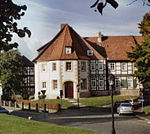Hildesheim Treasure

The Hildesheim Treasure, unearthed on October 17, 1868 in Hildesheim, Germany, is the largest collection of Roman silver found outside imperial frontiers. Most of it can be dated to the 1st century AD. The trove consists of about seventy exquisitely crafted solid silver vessels for eating and drinking and is now kept in the Antikensammlung Berlin (Altes Museum). It is generally believed that the treasure was the table service of a Roman commander, perhaps Publius Quinctilius Varus, who was militarily active in Germania. However, others also suggest that the treasure may have been war spoils rather than table service.The hoard was buried about 2 metres (6 ft 7 in) below the ground on Galgenberg Hill and was found by Prussian soldiers when preparing part of the area for a shooting range. Most scholars now accept that the entire Hildesheim Treasure was produced in frontier workshops of the northwestern Roman provinces.
Excerpt from the Wikipedia article Hildesheim Treasure (License: CC BY-SA 3.0, Authors, Images).Hildesheim Treasure
Silberfundstraße, Hildesheim Galgenberg (Marienburger Höhe/Galgenberg)
Geographical coordinates (GPS) Address Nearby Places Show on map
Geographical coordinates (GPS)
| Latitude | Longitude |
|---|---|
| N 52.142222222222 ° | E 9.9722222222222 ° |
Address
Landesbildungszentrum für Hörgeschädigte
Silberfundstraße 23
31141 Hildesheim, Galgenberg (Marienburger Höhe/Galgenberg)
Lower Saxony, Germany
Open on Google Maps










